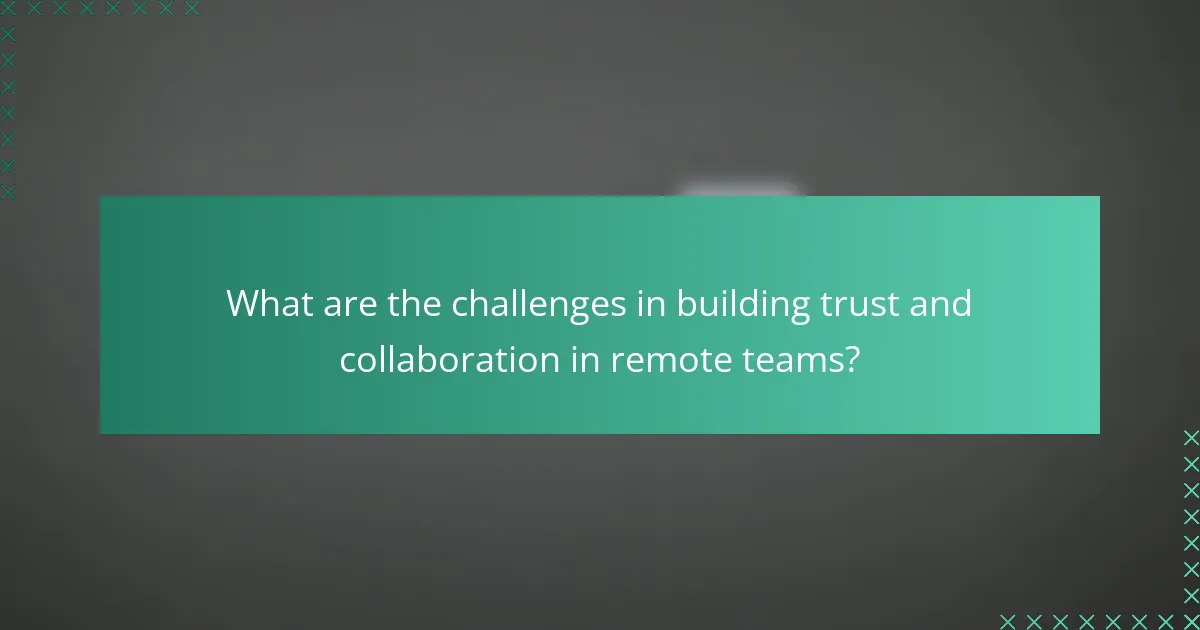Building trust and collaboration in remote teams is essential for fostering effective communication and teamwork among members working from diverse locations. Trust enhances interpersonal relationships, enabling open idea sharing and constructive feedback, while collaboration focuses on collective efforts toward achieving shared goals using various digital tools. Challenges such as communication barriers, lack of face-to-face interaction, and cultural differences can hinder trust development and team cohesion. Research indicates that high trust levels can boost team productivity by up to 50%, making strategies for building trust and collaboration critical for remote team success. Key strategies include fostering open communication, setting clear expectations, utilizing collaborative tools, and celebrating team achievements.

What is Building Trust and Collaboration in Remote Teams?
Building trust and collaboration in remote teams refers to the processes and strategies that enhance interpersonal relationships and teamwork among team members who work from different locations. Trust is essential for effective communication and cooperation in remote settings. It fosters a sense of safety and openness, enabling team members to share ideas and feedback freely. Collaboration involves working together towards shared goals, using various tools and technologies to coordinate efforts. Research indicates that teams with high trust levels are more productive and innovative. A study by Harvard Business Review shows that trust can improve team performance by up to 50%. Thus, building trust and collaboration is crucial for the success of remote teams.
Why is trust important in remote teams?
Trust is crucial in remote teams because it enhances communication and collaboration. When team members trust each other, they are more likely to share ideas and feedback openly. This openness leads to increased innovation and problem-solving capabilities. Trust also reduces misunderstandings and conflicts, which can be more challenging to resolve remotely. According to a study by the Harvard Business Review, teams with high trust levels are 50% more productive. Additionally, trust fosters a sense of belonging and commitment, resulting in lower turnover rates. In remote settings, where face-to-face interactions are limited, trust becomes even more essential for maintaining team cohesion and morale.
How does trust impact team performance?
Trust significantly enhances team performance. It fosters open communication among team members. When trust exists, individuals feel comfortable sharing ideas. This leads to increased collaboration and innovation. Research shows that high trust levels correlate with higher productivity. A study by the Institute for Corporate Productivity found that teams with high trust perform 50% better. Trust also reduces conflict and misunderstandings. This creates a more harmonious work environment, leading to better outcomes.
What are the signs of trust in remote teams?
Signs of trust in remote teams include open communication, accountability, and mutual respect. Team members share information freely and engage in honest discussions. They take responsibility for their tasks and deliver on commitments. Additionally, members show appreciation for each other’s contributions. Trust is evident when team members feel comfortable expressing concerns without fear of backlash. Regular feedback and recognition of achievements further enhance trust. Studies show that teams with high trust levels report increased collaboration and productivity.
What role does collaboration play in remote teams?
Collaboration is essential in remote teams as it fosters communication and enhances productivity. Remote teams often face challenges due to physical distance. Effective collaboration helps bridge this gap by facilitating information sharing. Tools like video conferencing and collaborative software improve engagement among team members. Research shows that teams that collaborate effectively can increase performance by up to 30%. Moreover, collaboration builds trust, which is crucial for remote work success. Trust enhances team cohesion and motivates members to contribute actively. Therefore, collaboration plays a pivotal role in the effectiveness and success of remote teams.
How does effective collaboration enhance team outcomes?
Effective collaboration enhances team outcomes by improving communication and fostering diverse perspectives. When team members collaborate, they share ideas and knowledge, leading to innovative solutions. This process reduces misunderstandings and increases clarity, resulting in more efficient workflows. Research shows that teams with effective collaboration can achieve up to 25% higher productivity. Additionally, collaboration builds trust among team members, which is crucial for remote teams. Trust leads to increased engagement and motivation, further enhancing team performance. Overall, effective collaboration is essential for achieving optimal team outcomes.
What tools facilitate collaboration in remote teams?
Collaboration tools for remote teams include platforms like Slack, Microsoft Teams, and Zoom. Slack allows for real-time messaging and file sharing among team members. Microsoft Teams integrates chat, video conferencing, and document collaboration in one platform. Zoom is primarily used for video meetings and webinars. These tools enhance communication and streamline workflows. Research indicates that effective collaboration tools can increase productivity by up to 30%. Using these tools helps remote teams maintain engagement and foster a collaborative environment.

How can remote teams build trust effectively?
Remote teams can build trust effectively by fostering open communication. Regular video calls help maintain personal connections. Sharing personal experiences during meetings encourages team bonding. Setting clear expectations enhances accountability among team members. Utilizing collaborative tools promotes transparency in project progress. Providing constructive feedback builds a culture of trust and support. Celebrating team achievements reinforces a sense of community. Research shows that teams with strong trust levels are 50% more productive.
What strategies can be implemented to foster trust?
Effective strategies to foster trust include open communication, transparency, and consistent feedback. Open communication allows team members to express thoughts and concerns freely. Transparency in decision-making builds confidence among team members. Consistent feedback ensures everyone is aligned with expectations and performance. Additionally, team-building activities can strengthen relationships. Establishing clear goals promotes accountability and trustworthiness. Recognizing individual contributions fosters a sense of value and belonging. According to a study by the Harvard Business Review, teams with high trust levels are 50% more productive.
How can open communication improve trust?
Open communication improves trust by fostering transparency and understanding among team members. It allows individuals to express their thoughts and concerns freely. This openness reduces misunderstandings and builds a sense of safety. When team members feel heard, they are more likely to reciprocate trust. Research indicates that teams with effective communication report higher levels of trust. For instance, a study by the Institute for Corporate Productivity found that organizations with strong communication practices have 47% higher employee engagement. This engagement directly correlates with increased trust levels. Thus, open communication is essential for cultivating trust in remote teams.
What role do team-building activities play in trust development?
Team-building activities play a crucial role in trust development among team members. These activities foster communication and collaboration, essential components of trust. Engaging in shared experiences allows individuals to understand each other’s strengths and weaknesses. This understanding leads to increased empathy and support within the team. Research shows that teams participating in structured activities report higher levels of trust. A study by the University of Central Florida found that team-building exercises significantly enhance interpersonal relationships. Therefore, team-building activities are effective in cultivating trust within teams.
How can leadership influence trust in remote teams?
Leadership can significantly influence trust in remote teams by establishing clear communication and expectations. Effective leaders prioritize regular check-ins and updates to foster transparency. They encourage open dialogue, allowing team members to voice concerns and share ideas. This openness creates a sense of safety and belonging. Leaders who demonstrate reliability and consistency in their actions further build trust. According to a study by the Harvard Business Review, teams with high trust levels are 50% more productive. Additionally, leaders who recognize and celebrate team achievements reinforce positive relationships and trust. By modeling trustworthiness, leaders set the tone for team dynamics, enhancing collaboration and performance.
What leadership styles are most effective in remote settings?
Transformational and servant leadership styles are most effective in remote settings. Transformational leaders inspire and motivate team members. They foster a shared vision and encourage innovation. This approach enhances engagement and productivity among remote workers. Servant leaders prioritize the needs of their team. They focus on empowering individuals and building strong relationships. Research shows that these styles improve trust and collaboration in remote teams. A 2020 study by Zaccaro et al. highlights the importance of emotional intelligence in remote leadership. It indicates that leaders who exhibit these styles can create a supportive remote work environment.
How can leaders model trust-building behaviors?
Leaders can model trust-building behaviors by demonstrating transparency and consistency. They should communicate openly about goals and challenges. Regularly sharing updates fosters an environment of honesty. Consistent actions align with spoken values, reinforcing reliability. Leaders must also actively listen to team members’ concerns. This approach shows respect and validates their input. Providing constructive feedback encourages growth and development. Additionally, recognizing and celebrating team achievements builds morale and trust. Research indicates that trust enhances collaboration and productivity, essential in remote teams.

What are the challenges in building trust and collaboration in remote teams?
The challenges in building trust and collaboration in remote teams include communication barriers, lack of face-to-face interaction, and cultural differences. Communication barriers can lead to misunderstandings and misinterpretations. Remote teams often rely on digital communication tools, which may not convey tone or intent effectively. Lack of face-to-face interaction reduces opportunities for building personal relationships. This absence can hinder team bonding and trust development. Cultural differences may also create misunderstandings regarding work ethics and communication styles. These challenges can impact team cohesion and overall productivity. Research shows that teams with high trust levels are 50% more productive.
What common obstacles do remote teams face?
Remote teams face several common obstacles. Communication issues often arise due to lack of face-to-face interaction. Time zone differences can complicate scheduling meetings and collaboration. Isolation may lead to decreased morale and connection among team members. Technology challenges, such as unreliable internet or software glitches, can disrupt workflow. Misalignment of goals and expectations can create confusion and hinder productivity. Lastly, cultural differences may affect team dynamics and collaboration styles. These obstacles can significantly impact the effectiveness of remote teams.
How can time zone differences affect collaboration?
Time zone differences can significantly impact collaboration among remote teams. They create challenges in scheduling meetings and aligning work hours. For instance, a team in New York may find it difficult to coordinate with a team in Tokyo due to a 14-hour difference. This can lead to delays in communication and decision-making.
Moreover, asynchronous communication may result in misunderstandings or missed messages. According to a study by Buffer, 20% of remote workers cite communication issues as a major challenge. Additionally, time zone differences can affect team morale and engagement. When team members are unable to collaborate in real-time, it may lead to feelings of isolation.
Effective strategies, such as flexible working hours and clear communication protocols, can help mitigate these issues. Implementing tools that facilitate asynchronous collaboration can also improve productivity.
What impact does lack of face-to-face interaction have on trust?
Lack of face-to-face interaction negatively impacts trust. Trust is built through personal connections and non-verbal cues. When communication occurs remotely, these cues are often absent. This absence can lead to misunderstandings and misinterpretations. Research shows that teams with frequent in-person interactions report higher trust levels. A study by the University of California found that face-to-face communication fosters stronger relationships. In contrast, remote interactions can create feelings of isolation. This isolation can diminish trust over time. Therefore, the lack of face-to-face interaction can significantly undermine trust in remote teams.
How can teams overcome these challenges?
Teams can overcome challenges in building trust and collaboration by implementing regular communication practices. Establishing daily or weekly check-ins fosters transparency and connection. Utilizing video conferencing tools enhances personal interaction, making team members feel more engaged. Setting clear expectations and goals helps align team efforts. Encouraging open feedback creates a culture of trust and improvement. Participating in team-building activities, even virtually, strengthens relationships and camaraderie. Providing opportunities for informal interactions allows team members to connect on a personal level. Research indicates that teams with strong communication practices report higher levels of trust and collaboration.
What best practices can enhance team cohesion despite challenges?
Encouraging open communication enhances team cohesion despite challenges. Regular check-ins allow team members to express concerns and share updates. Utilizing collaborative tools fosters real-time interaction and reduces feelings of isolation. Setting clear goals aligns team efforts and reinforces a shared purpose. Recognizing individual contributions boosts morale and strengthens bonds. Providing opportunities for team-building activities cultivates trust and camaraderie. Establishing a feedback culture promotes continuous improvement and mutual respect. These practices are supported by studies showing that effective communication and recognition lead to higher team satisfaction and performance.
What practical tips can improve trust and collaboration in remote teams?
Establishing regular communication is crucial for improving trust and collaboration in remote teams. Regular check-ins create a routine for team members to share updates and concerns. Utilizing video calls enhances personal connections and fosters engagement. Encouraging open feedback allows team members to express thoughts and ideas freely. Setting clear goals aligns team members on objectives and expectations. Promoting team-building activities strengthens relationships and camaraderie. Recognizing individual contributions boosts morale and trust among team members. Lastly, providing resources for professional development encourages growth and collaboration. These practices have been shown to enhance teamwork and trust in remote environments.
Building trust and collaboration in remote teams is essential for enhancing interpersonal relationships and teamwork among members who work from different locations. This article explores the importance of trust in remote settings, its impact on team performance, and the role of effective collaboration in achieving shared goals. Key strategies for building trust, such as open communication and team-building activities, are discussed alongside the challenges remote teams face, including communication barriers and cultural differences. Additionally, the article highlights practical tips and tools that can facilitate collaboration and strengthen team cohesion, ultimately leading to improved productivity and innovation.
